Autoptimize acelera seu siste ao otimizar JS, CSS, imagens (incluindo carregamento tardio), HTML e fontes do Google, deixando JS assíncronos, removendo os emojis e mais.
Media Library Assistant
Hospedagem WordPress com plugin Media Library Assistant
Onde posso hospedar o plugin Media Library Assistant?
Este plugin pode ser hospedado em qualquer hospedagem que possua WordPress instalado. Recomendamos fortemente optar por uma hospedagem confiável, com servidores especializados para WordPress, como o serviço de hospedagem de sites da MCO2.
Hospedando o plugin Media Library Assistant em um provedor seguro
A MCO2, além de configurar e instalar o WordPress na versão mais atualizada para seus clientes, disponibiliza o plugin WP SafePress, um mecanismo exclusivo que assegura e melhora seu site conjuntamente.
Por que a Hospedagem WordPress funciona melhor na MCO2?
A Hospedagem WordPress funciona melhor pois a MCO2 possui servidores otimizados para WordPress. A instalação de WordPress é diferente de uma instalação trivial, pois habilita imediatamente recursos como otimização de imagens, proteção da página de login, bloqueio de atividades maliciosas diretamente no firewall, cache avançado e HTTPS ativado por padrão. São plugins que potencializam seu WordPress para a máxima segurança e o máximo desempenho.
The Media Library Assistant provides several enhancements for managing the Media Library, including:
-
The
[mla_gallery]shortcode, used in a post, page or custom post type to add a gallery of images and/or other Media Library items (such as PDF documents). MLA Gallery is a superset of the WordPress[gallery]shortcode; it is compatible with[gallery]and provides many enhancements. These include: 1) full query and display support for WordPress categories, tags, custom taxonomies and custom fields, 2) support for all post_mime_type values, not just images 3) media Library items need not be “attached” to the post, and 4) control over the styles, markup and content of each gallery using Style and Markup Templates. Twenty-eight hooks are provided for complete gallery customization from your theme or plugin code. -
The
[mla_tag_cloud]shortcode, used in a post, page, custom post type or widget to display the “most used” terms in your Media Library where the size of each term is determined by how many times that particular term has been assigned to Media Library items. Twenty-five hooks are provided for complete cloud customization from your theme or plugin code. -
The
[mla_term_list]shortcode, used in a post, page, custom post type or widget to display hierarchical (and flat) taxonomy terms in list, dropdown control or checklist formats. Twenty hooks are provided for complete list customization from your theme or plugin code. -
The
[mla_custom_list]shortcode, used in a post, page, custom post type or widget to display flat lists, dropdown controls and checkbox lists of custom field values. Twenty-seven hooks are provided for complete list customization from your theme or plugin code. -
Support for WPML and Polylang multi-language CMS plugins. MLA has earned a place on WPML’s List of Recommended Plugins.
-
Integrates with Photonic Gallery, Justified Image Grid, Jetpack and other plugins, so you can add slideshows, thumbnail strips and special effects to your
[mla_gallery]galleries. -
Works with WordPress Real Media Library: Media Library Folder & File Manager (Lite and Pro) to organize your files into folders, collections and galleries. This combination enhances both the Media/Assistant admin submenu and the
[mla_gallery]shortcode. -
Works with CatFolders – WP Media Folders (Lite and Pro) to categorize media files better and faster. This combination enhances both the Media/Assistant admin submenu and the
[mla_gallery]shortcode. -
Powerful Content Templates, which let you compose a value from multiple data sources, mix literal text with data values, test for empty values and choose among two or more alternatives or suppress output entirely.
-
Attachment metadata such as file size, image dimensions and where-used information can be assigned to WordPress custom fields. You can then use the custom fields in your
[mla_gallery]display and you can add custom fields as sortable, searchable columns in the Media/Assistant submenu table. You can also modify the WordPress_wp_attachment_metadatacontents to suit your needs. -
IPTC, EXIF (including GPS), XMP and PDF metadata can be assigned to standard WordPress fields, taxonomy terms and custom fields. You can update all existing attachments from the Settings page IPTC/EXIF tab, groups of existing attachments with a Bulk Action or one existing attachment from the Edit Media/Edit Single Item screen. Twelve hooks provided for complete mapping customization from your theme or plugin code. You can view and/or download this PDF document with more information: Mapping File Metadata to WordPress Fields with Media Library Assistant
-
Complete control over Post MIME Types, File Upload extensions/MIME Types and file type icon images. Fifty four (54) additional upload types, 112 file type icon images and a searchable list of over 1,500 file extension/MIME type associations.
-
Enhanced Search Media box. Search can be extended to the name/slug, ALT text and caption fields. The connector between search terms can be “and” or “or”. Search by attachment ID or Parent ID is supported, and you can search on keywords in the taxonomy terms assigned to Media Library items. Works in the Media Manager Modal Window, too.
-
Complete support for ALL taxonomies, including the standard Categories and Tags, your custom taxonomies and the Assistant’s pre-defined Att. Categories and Att. Tags. You can add taxonomy columns to the Assistant listing, filter on any taxonomy, assign terms and list the attachments for a term.
-
Taxonomy and custom field support in the ATTACHMENT DETAILS pane of the Media Manager Modal Window and Media/Library Grid view.
-
Inline “Bulk Edit” and “Quick Edit” areas; update author, parent and custom fields, add, remove or replace taxonomy terms for several attachments at once. Works on the Media/Add New screen as well.
-
Displays more attachment information such as parent information, file URL and image metadata. Provides many more listing columns (more than 20) to choose from.
-
Provides additional view filters for MIME types and taxonomies, and features to cmpose custom views of your own.
-
Works with the popular Admin Columns plugins for even more Media/Assistant screen customization.
The Assistant is designed to work like the standard Media Library pages, so the learning curve is short and gentle. Contextual help is provided on every new screen to highlight new features.
NOTE: Complete documentation is included in the Documentation tab on the Settings/Media Library Assistant admin screen and the drop-down “Help” content in the admin screens. You can find a stand-alone version of the Documentation on my web site: Media Library Assistant Documentation
I do not solicit nor accept personal donations in support of the plugin. WordPress and its global community means a lot to me and I am happy to give something back.
If you find the Media Library Assistant plugin useful and would like to support a great cause, consider a tax-deductible donation to our Chateau Seaview Fund at the ALS Network. Every dollar of the fund goes to make the lives of people with ALS, their families and caregivers easier. Thank you!
Acknowledgements
Media Library Assistant includes many images drawn (with permission) from the Crystal Project Icons, created by Everaldo Coelho, founder of Yellowicon.
Many thanks to Aurovrata Venet, Il’ya Karastel and Kristian Adolfsson for testing and advising on the multilingual support features!
The Example Plugins
The MLA example plugins have been developed to illustrate practical applications that use the hooks MLA provides to enhance the admin-mode screens and front-end content produced by the MLA shortcodes. Most of the examples are drawn from topics in the MLA Support Forum.
The Documentation/Example Plugins submenu lets you browse the list of MLA example plugins, install or update them in the Plugins/Installed Plugins area and see which examples you have already installed. To activate, deactivate or delete the plugins you must go to the Plugins/Installed Plugins admin submenu.
The Example plugins submenu lists all of the MLA example plugins and identifies those already in the Installed Plugins area. In the submenu:
- the “Screen Options” dropdown area lets you choose which columns to display and how many items appear on each page
- the “Help” dropdown area gives you a brief explanation of the submenu content and functions
- the “Search Plugins” text box lets you filter the display to items containing one or more keywords or phrases
- bulk and rollover actions are provided to install or update example plugins
- the table can be sorted by any of the displayed columns
Once you have installed an example plugin you can use the WordPress Plugins/Editor submenu to view the source code and (with extreme caution) make small changes to the code. Be very careful if you choose to modify the code! Making changes to active plugins is not recommended. If your changes cause a fatal error, the plugin will be automatically deactivated. It is much safer to download the file(s) or use FTP access to your site to modify the code offline in a more robust HTML/PHP editor.
You can use the “Download” rollover action to download a plugin to your local system. Once you have made your modifications you can copy the plugin to a compressed file (ZIP archive) and then upload it to your server with the Plugins/Add New (Upload Plugin) admin submenu.
If you do make changes to the example plugin code the best practice is to save the modified file(s) under a different name, so your changes won’t be lost in a future update. If you want to retain the file name, consider changing the version number, e.g. adding 100 to the MLA value, so you can more easily identify the plugins you have modified.
Capturas de tela

The Media/Assistant submenu table showing the enhanced search box, taxonomy filter and custom views; also shows the Quick Edit area.

The Media/Assistant submenu table showing the Bulk Edit area with taxonomy Add, Remove and Replace options; also shows metadata mapping buttons.
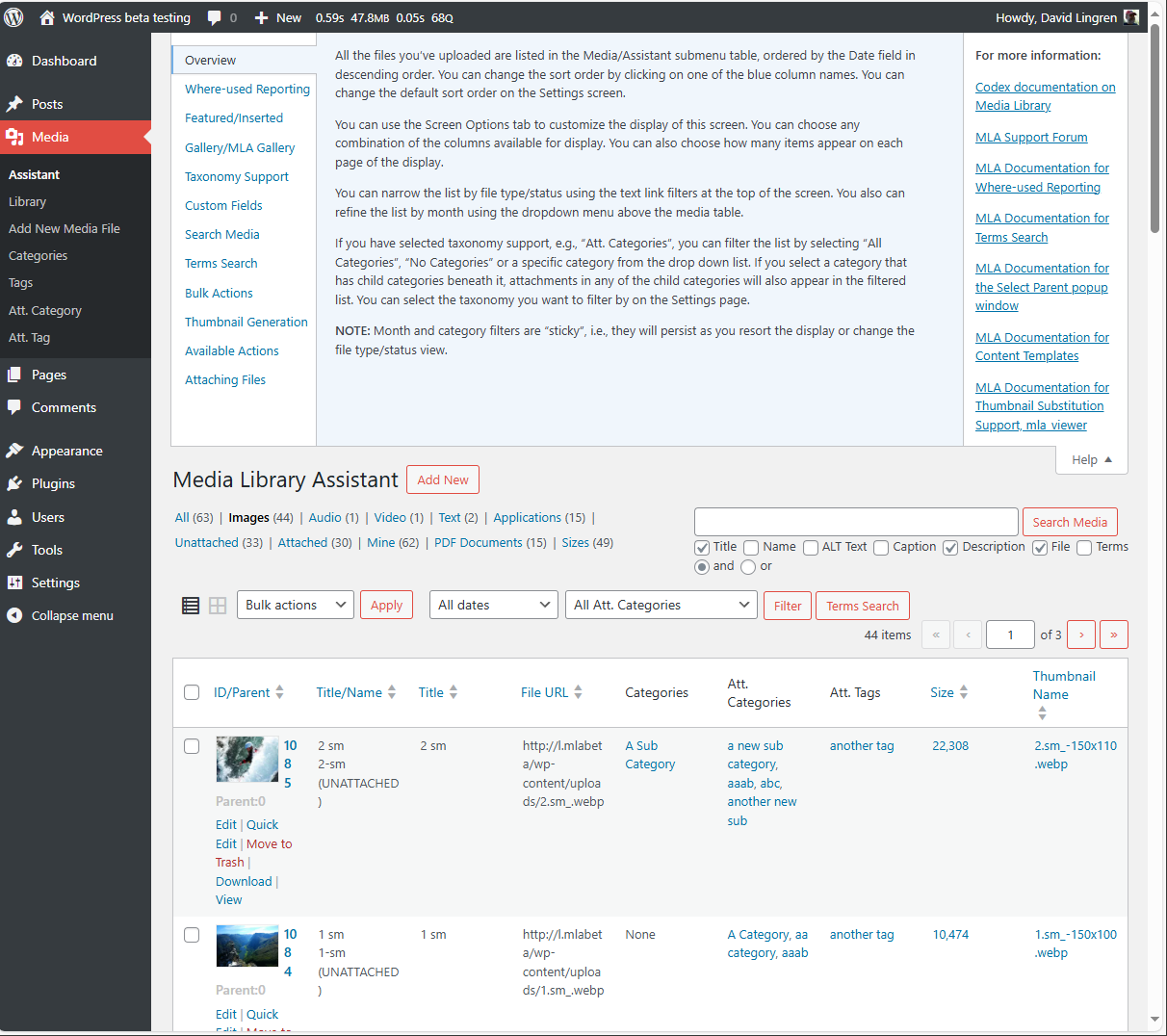
The Media/Assistant submenu table showing the pulldown Help menu and tabs..

The Media Manager popup modal window showing additional filters for date and taxonomy terms. Also shows the enhanced Search Media box and the full-function taxonomy support in the ATTACHMENT DETAILS area.

The Search Terms popup modal window, which lets you filter the items displayed by searching for keywords and phrases in taxonomy term names.

The Media/Upload New Media submenu page showing the Bulk Edit area to spply templates and mapping rules to items as they are uploaded.
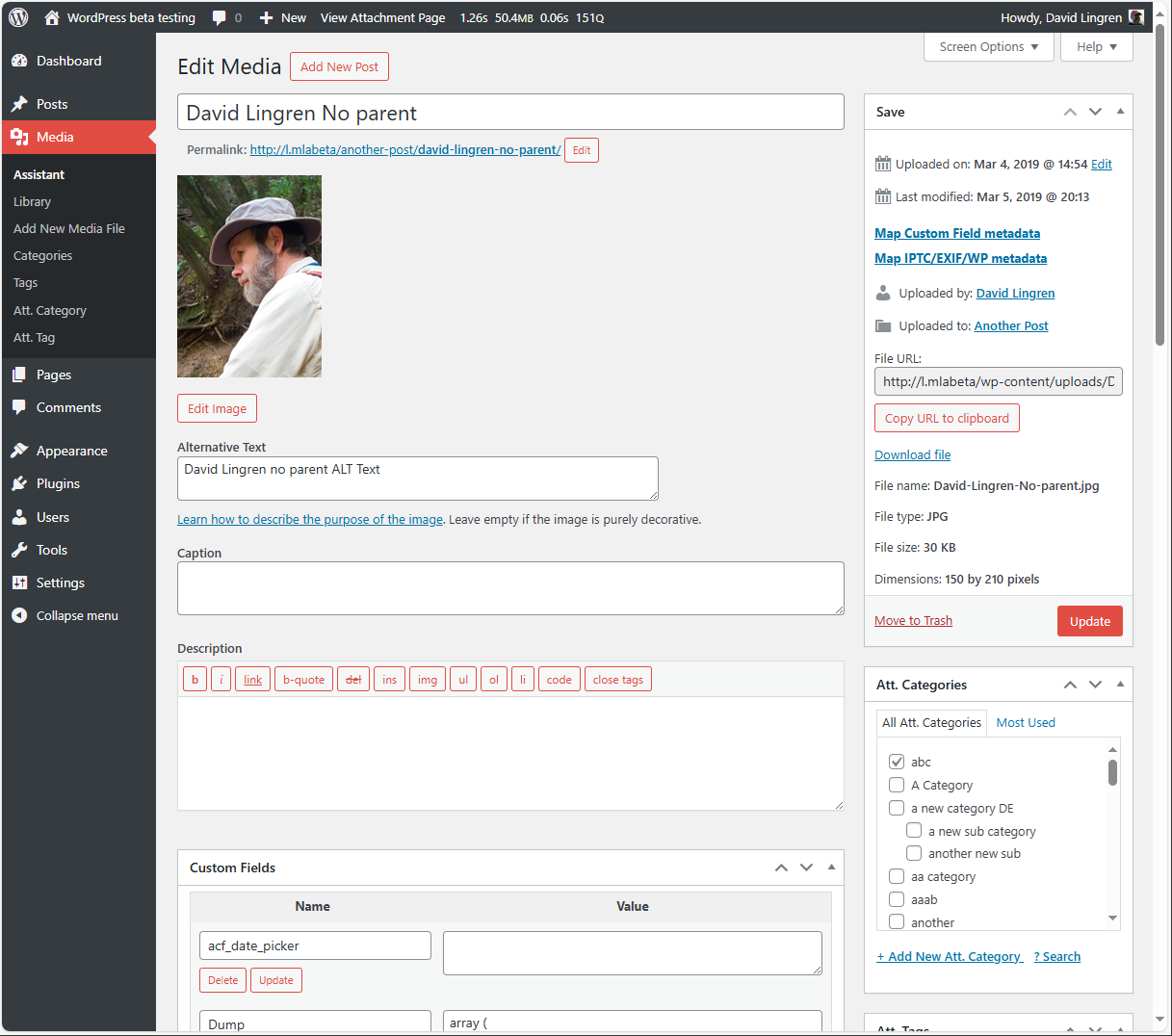
The enhanced Edit page showing additional fields, mapping rule buttons and taxonomy boxes.
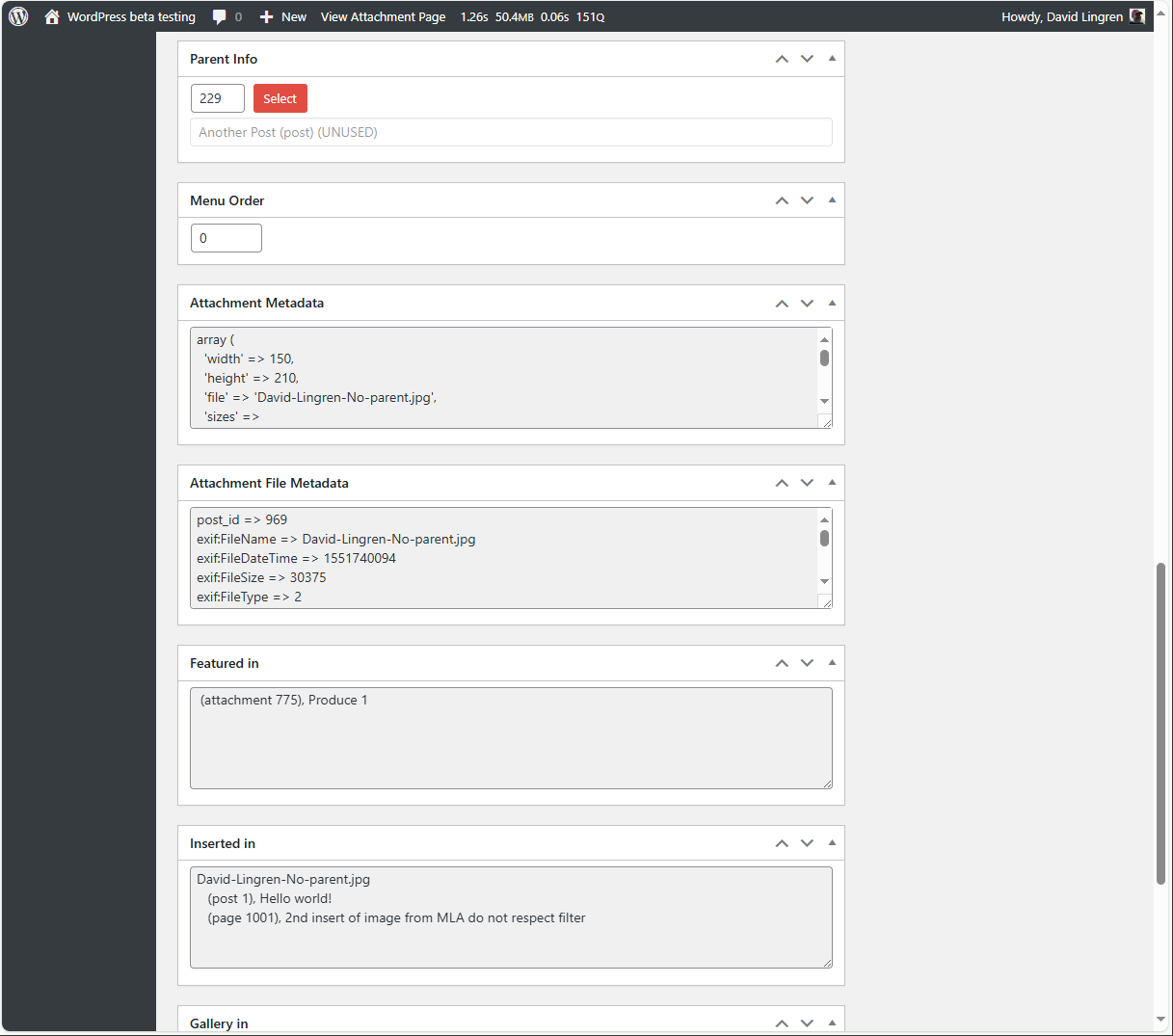
The enhanced Edit page showing parent selection, metadata display boxes and where-used reporting boxes.
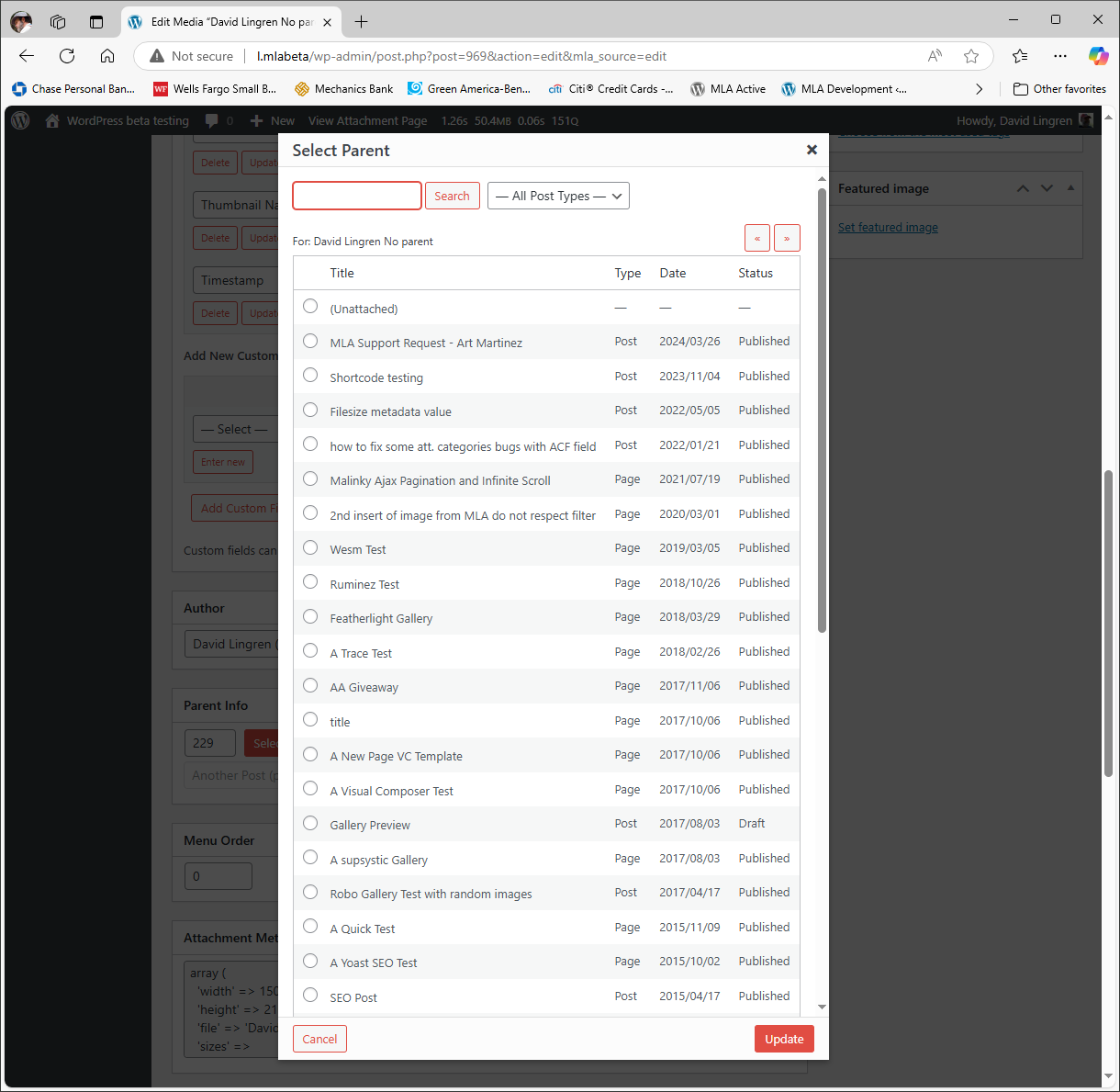
The enhanced Edit page showing the Select Parent popup window for easy parent post/page editing.

The Settings page General tab, where you can customize where-used reporting and many other options.

The Settings page General tab, showing the Taxonomy Support options and some of the the Media/Assistant display options.

The Settings page General tab, showing the Media Manager and Media/Library Grid Mode enhancement options.
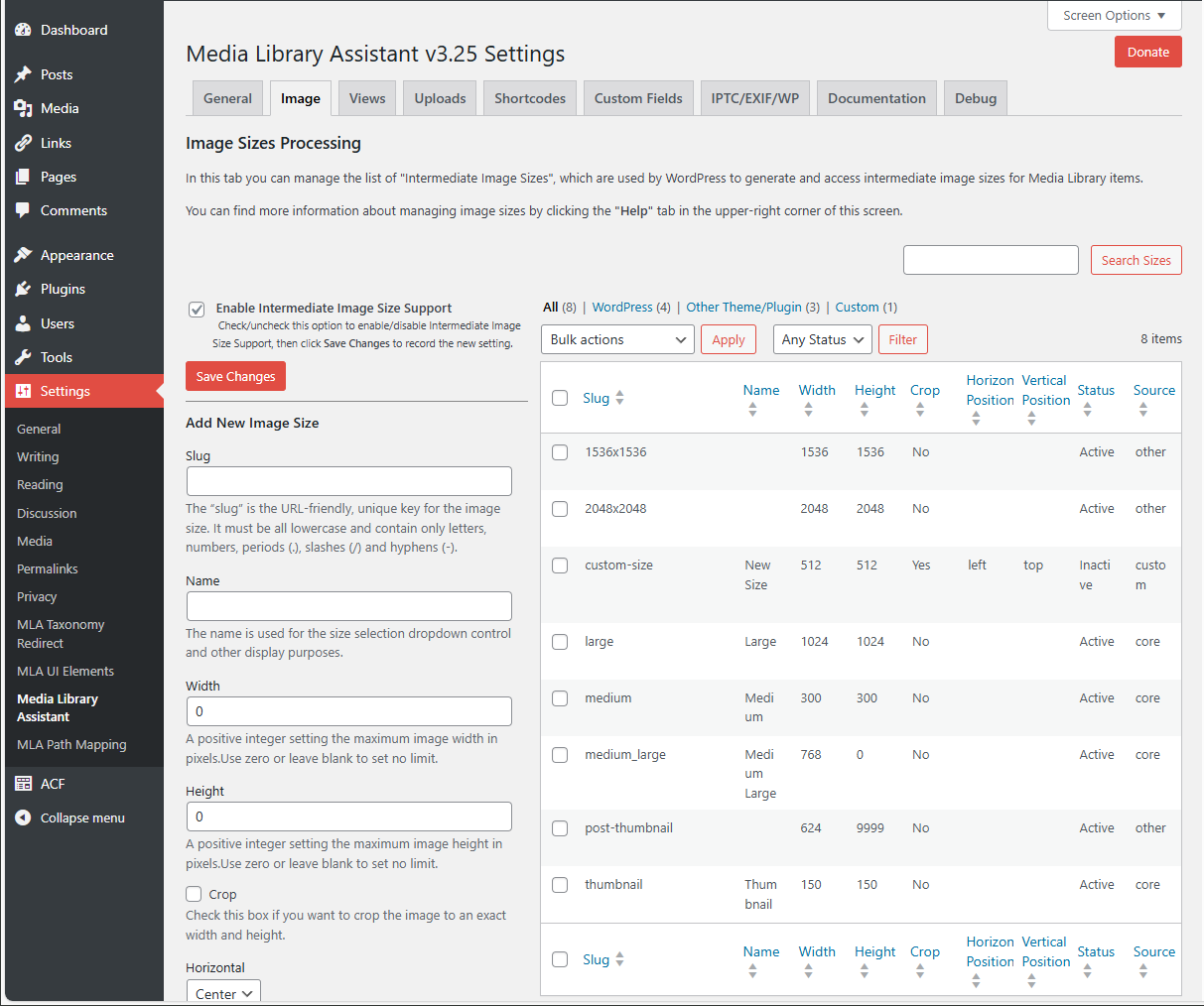
The Settings page Image tab, where you can add and manage Intermediate Sizes for Media Library image items.
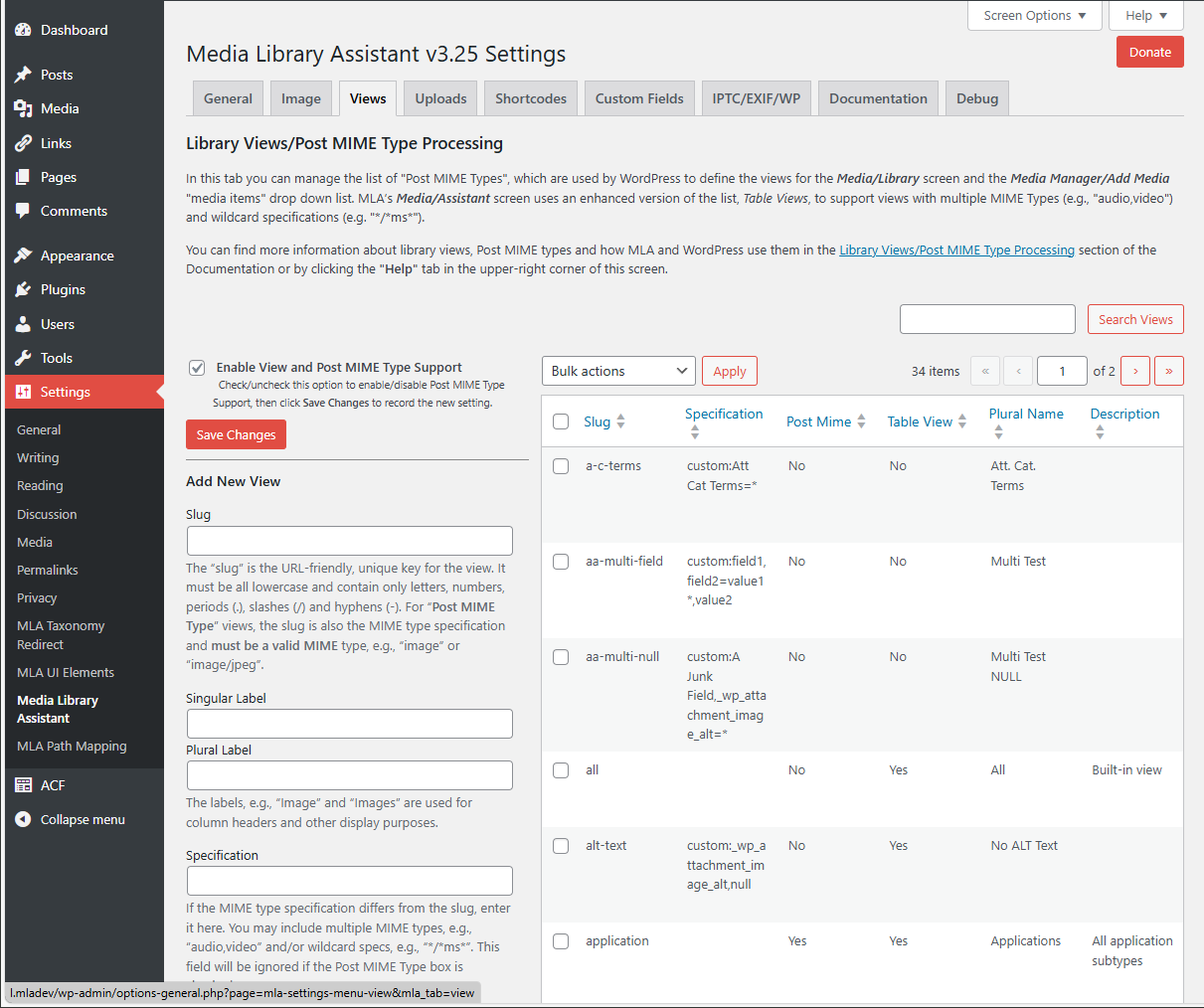
The Settings page Views tab, where you can add and manage MIME Types and define Media/Assistant table views.

The Settings page Uploads tab, where you can add and manage allowed file types and corredponding icons.

The Settings page Shortcodes tab, where you can add and manage custom style and markup templates for the MLA shortcodes.
![The Settings page Custom Fields tab, where you can map attachment metadata to custom fields for display in [mla_gallery] shortcodes and as sortable, searchable columns in the Media/Assistant submenu.](https://ps.w.org/media-library-assistant/assets/screenshot-17.png?rev=3264735)
The Settings page Custom Fields tab, where you can map attachment metadata to custom fields for display in [mla_gallery] shortcodes and as sortable, searchable columns in the Media/Assistant submenu.

The Settings page IPTC/EXIF/WP Processing Options screen, where you can map image metadata to standard fields (e.g. caption), taxonomy terms and custom fields.

The Settings page Documentation tab, a complete reference to MLA shortcodes and features.

The Settings page Documentation/Example Plugins tab, showing the many optional plugins you can use or adapt to extend MLA features.

The Settings page Debug tab, where you can activate debug logging categories as well as manage and display the error log.
